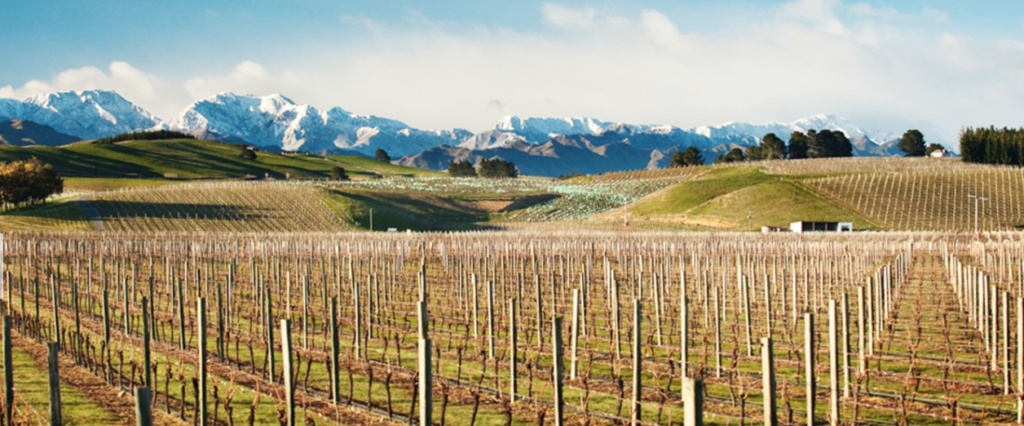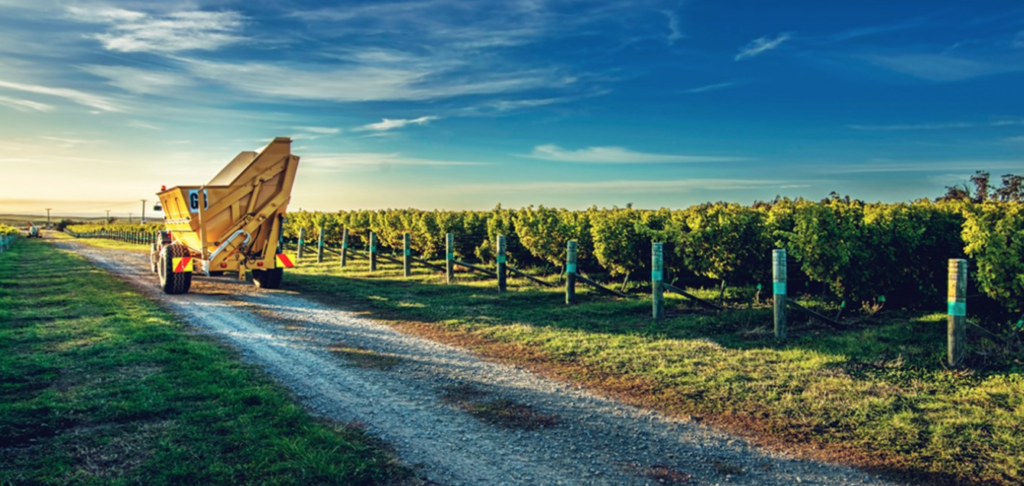Marlborough is New Zealand’s largest wine region and its most significant in terms of wine production. It is especially known for its Sauvignon Blanc. In this Marlborough wine region guide we look into all the terroir essentials for the wine region – Marlborough’s soils, the climate, the viticulture and winemaking – and explore Marlborough’s wine history and future with Sauvignon Blanc and beyond. Scroll down for the full guide with videos, photography and key statistics on Marlborough’s wine production.
Where is Marlborough anyway?
Situated on the northeastern tip of South Island, in a natural bay, Marlborough is New Zealand’s main wine region because its location is protected from the cold westerly winds from the south-east and also from the wet weather experienced by North Island, making it ideal for wine production. The closest major city is Nelson, some 100km away.
Marlborough wine region guide
A History of Marlborough’s viticultural pioneers
Marlborough’s viticultural pioneer was David Herd, who first planted vines in 1873 and started making his own wine from Brown Muscat. However Herd’s small production disappeared over time, and viticulture in Marlborough didn’t reemerge until 1973 with a vineyard planted by Montana, now known as Brancott Estate (which proudly touts itself as having made the first Marlborough Sauvignon Blanc). A handful of wine producers began small levels of commercial production in the late 1970s and early 1980s and this is considered the first wave of Marlborough’s wine plantations. By the end of the 1980s, a few hundred hectares of vines had been planted.
In the late 1990s, the second wave, a much larger one, arrived and Marlborough boomed well into the late 2000s. The wine region grew at an outstanding rate, growing from 5,730 hectares in 2002 to 22,000 in 2008. At its peak, up to 3000 hectares of vines were being planted on an annual basis. The credit crunch in 2008 put a halt to that boom and Marlborough went from being outstripped by demand, to having a glut of oversupply.
Today the market has normalised and Marlborough is undergoing its third wave of vineyard plantings, but mainly by existing producers rather than new investors and at a much more moderate rate. Today, the Marlborough wine region has 26,000 hectares planted.

Marlborough: one of the fast growing New World wine regions (nzwine.com)
Production Area & Volume: Marlborough wine region guide
Marlborough is by far the largest wine region in New Zealand, accounting for over two-thirds of New Zealand’s vineyards.
- Over 26,000 hectares of vines planted in Marlborough
- 510 growers in Marlborough
- 141 wineries in Marlborough
- 68% of New Zealand’s total production comes from Marlborough
The Essentials of Terroir: Marlborough wine region guide
Climate & Soils in Marlborough
Marlborough has a maritime climate and is the sunniest wine region in New Zealand. Its free-draining soils and moderate to low rainfall, in combination with plenty of breezes keep vines dry and healthy, and the cool evening temperatures and warm, sunny daytime temperatures allow for good ripening and acidity retention. It’s no coincidence that this is the most planted region in New Zealand; Marlborough does have an ideal climate for vine growing.
Rainfall in Marlborough
650mm a year, spread throughout the year. Some producers do irrigate through drip irrigation.
Other Climate Notes
Frost is a significant risk in spring, when it can negatively impact yields, and also just before harvest, when it causes problems for ripening. Wind turbines, frost pots and sprinkler systems are installed in almost all of the vineyards in Marlborough, especially in the southern valleys and Awatere, where frost is a greater risk.

Wind turbines in the vineyards for frost (nzwine.com)
Marlborough has very strong winds, which are good for vine health. However they can cause dehydration (making irrigation necessary) and they can also hamper vigour, which is not necessarily a bad thing for the usually vigorous variety of Sauvignon Blanc.
Soils in Marlborough
The soils depend on the valley or sub-region of Marlborough:
- In general, the Wairau valley has alluvial soils, as it is located in the old river bed. Higher up in the Wairau valley, the Rapaura district has the stoniest soils, with large rounded river stones, called greywacke, with a thin top layer of sandy loam. In the lower Wairau, the soils become more loam-based and fertile with higher water retention.
- The southern valleys, which are glacial valleys, have soils with more clay and wind-blown loess.
- Awatere valley, where the vineyards are planted on large river terraces, has soils which are a combination of gravel, silt-loam and wind-blown loess.

Soils in Marlborough: glacial vs. river stones (80harvests)
Video of Cloudy Bay’s Nicky Hewett talking about the different soils of Wairau Valley:
Marlborough Longitude
173.9°E
Marlborough Latitude
41.5°S
Altitude in Marlborough wine region
Vineyards range between 50 to 800 meters above sea level (although most are lower altitude)
Viticulture Facts & Vineyard Management: Marlborough wine region guide
The original vines were all planted on their own roots. However, phylloxera arrived in the late 1980s and was widespread by the early 1990s and since then vines have been grafted onto American rootstocks. There is increasing experimentation with different clones in Marlborough today and vines are VSP-trained with wide spaces between vine rows so that tractors can pass (as the majority of the Marlborough wine region is machine-harvested and farmed).

Marlborough viticulture & machine farming (nzwine.com)
Vine Training systems in Marlborough
Modern VSP (usually with drip irrigation)
Harvest Time in Marlborough
March to April
Other Viticultural Challenges in Marlborough wine region
Powdery mildew is becoming increasingly common in Marlborough, and there are some cases of Eutypa dieback.
Birds (of which the population is huge) can decimate a vineyard within an hour, eating all the fruit on the site. Netting is frequently used (especially at the higher value vineyards) and there are attempts to repopulate the region with birds of prey.
Grape Varieties: Marlborough wine region guide
Marlborough is Sauvignon Blanc territory, it makes up over 85% of plantings. There are also significant quantities of Pinot Noir being produced and some exciting other varieties:
- Sauvignon Blanc 85%
- Pinot Noir 6%
- Chardonnay 3%
- Pinot Gris 3%
- Riesling <1%
- Others <1%
Want to know what Marlborough Sauvignon Blanc tastes like? Watch this live tasting at Cloudy Bay.
If you are interested in Marlborough Pinot Noir, try this video.
Sub-regions in Marlborough
Winemaker Clive Jones describes the main sub-regions of Marlborough and how their soils and climate are different:
Wairau Valley
To the south of the Wairau river, this is the main wine region of Marlborough and home to most plantings. It is effectively a river bed with stony alluvial soils. This is the region where the rain falls first and it has a slightly higher rainfall than the others. Although it is the warmest of the Marlborough valleys, it is classed as cool climate. It is best known for Sauvignon Blanc with tropical aromas.
Sub-regions within Wairau: Rapaura, Lower Wairau, Conder’s Bend, Renwick, Kaituna
Southern Valleys
The sloped hillsides facing the Wairau Valley sit in between Wairau and Awatere and the climate is somewhere in the middle too in terms of rainfall and heat. The flat parts of the southern valleys are quite frost-prone, although the hillside plantations are more protected. The soil tends to have more clay and better water retention and this is a sub-region well known for its Pinot Noir.
Awatere Valley
Passing the southern valleys and more hillsides, you reach the Awatere Valley – approximately 30km from Blenheim and based on river terraces of different altitudes with gravel, loam and loess soils. This is the coldest, windiest and driest of the valleys. It is also the valley most prone to frost. The Sauvignon Blanc here tends to be more on the herbaceous side.
Interesting Fact
The Maori call Marlborough ‘Kei puta the Wairau’. It translates as ‘the place with the hole in the cloud’, which gives you an indication of exactly how sunny it is in Marlborough!
[mepr-hide if=”rule: 2080″] . Did you find this Marlborough wine region guide useful? Our fast facts and study guides are usually content for subscribers, please support 80 Harvests by becoming a member and get unrestricted access to all our content. Thank you for supporting the journey and being part of the 80 Harvests community! [mepr-group-price-boxes group_id=”2070″] [/mepr-hide]
[mepr-show if=”rule: 2080″]


